
Coronavirus: fear, infection, protection and media
The coronavirus has broken out. Statistically, the risk of infection in Switzerland and worldwide is negligible. Nevertheless, the World Health Organization has declared the virus a global health emergency and the media can’t get enough of reporting about the subject. Let's take a critical look at what's happening.
The coronavirus has broken out. People are dying. The world is in turmoil. Protective masks and disinfectants are swept off the shelves. Ideas of apocalyptic scenarios have taken over the minds of people in Switzerland. They're scared of picking up the coronavirus and, in the worst case, dying of it.
Both the World Health Organization WHO and the media are speaking of an epidemic. However, it wasn't until 30 January 2020 that the WHO didn't declare a «Public Health Emergency of International Concern» (PHEIC). This concept was developed after the SARS crisis in 2002 and 2003 and defines a state in which an infectious disease is not only a problem of an individual or individual nation states, but one that the international community must deal with immediately. Five PHEICs have been declared since 2009. Twice for Ebola (2014 and 2019/2020), once each for swine flu (2009), polio (2014) and the Zika virus (2016).
The WHO Emergency Committee is currently discussing whether the coronavirus should be declared a PHEIC.
Striving not to cause panic, the WHO paints a cautious but optimistic picture in its public documents. Yet, the media reports – in Switzerland as well as internationally – make it seem as if the world was facing an apocalypse; with China being on the verge of elimination and Switzerland next in line. Scare tactics or the truth? Let’s take a look at the facts.
Coronavirus: infection and symptoms
The coronavirus that's spreading these days is called Novel Coronavirus or 2019-nCoV. The term «coronavirus» describes a family of viruses that includes the Middle East Respiratory Syndrome- (MERS-CoV) and Severe Acute Respiratory Syndrome-Virus (SARS-CoV). The epidemic Novel Coronavirus 2019-nCoV has not yet been detected in humans until Chinese officials reported an outbreak on 31 December 2019. Since then, 6,065 cases of 2019-nCoV infection have been reported worldwide, 5,997 of them in China.

Coronaviruses are zoonotic, meaning they are transmitted from animals to humans. Detailed investigations found that SARS-CoV was transmitted from civet cats to humans and MERS-CoV from dromedary camels to humans. Several known coronaviruses are circulating in animals that have not yet infected humans.
The signs of infection include:
- fever
- cough
- shortness of breath
- breathing difficulties
In severe cases, infection with a coronavirus can cause pneumonia, severe acute respiratory syndrome (SARS), kidney failure or even death.
Cases of infection and the spread of the virus
As of 29 January 2020, the WHO is aware of 6,065 confirmed case of infection with the coronavirus worldwide. Of these, 5,997 cases are in China and 68 in the rest of the world. According to data analysis by John Hopkins University, four people are infected with the virus in Germany, five people in France and one person in Finland.
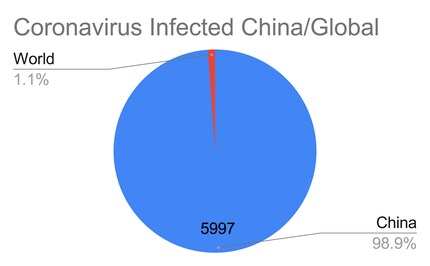
All deaths associated with the coronavirus happened in China – according to the WHO, a total of 132 so far. In the context of infections, this means that 2.1 percent of those infected have died of the disease.
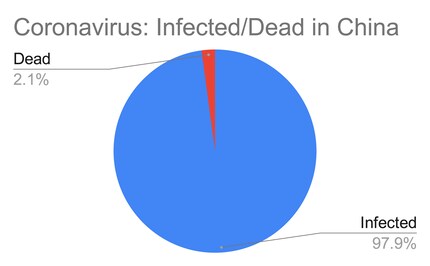
To keep an eye on the situation, the WHO doesn’t only record the number of infections and deaths, but also the number of suspected cases. By 29 January, the WHO had reported 9,239 suspected cases in China. This means that 60.1 percent of the persons suspected of being infected with the virus turned out to be infected.
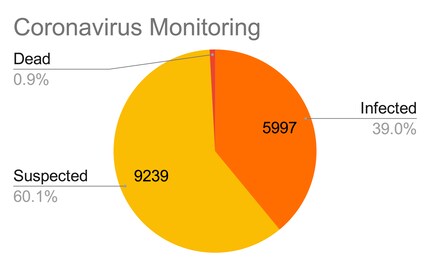
The death rate in this context is 0.9 percent. At a WHO press conference, journalist Li Zengxin of the business magazine Caixin Media asked if the victims of the virus have any shared characteristics.
The response was given by Maria van Kerkhove, Head of the Outbreak Investigation Task Force and a technical consultant with WHO:
So there have been some deaths associated with this outbreak, and from the information so far there are some characteristics of those individuals. Many of them have had underlying conditions, underlying medical conditions, and have been of older age. So based on our past experience with other respiratory pathogens, advanced age and underlying conditions are known risk factors for developing severe disease and death.
According to the WHO, people who are in good health have a high chance of surviving the virus unscathed.
Protective measures against the virus
According to a WHO assessment, the global infection rate is «high». In China even «very high». Therefore, protective measures are important especially for those who are elderly and/or prone to illness.
The WHO has published a guide with advice for the public. These recommendations reduce exposure to and transmission of a range of illnesses.
- Frequently clean hands by using alcohol-based hand rub or soap and water.
- When coughing and sneezing cover mouth and nose with flexed elbow or tissue – throw tissue away immediately and wash hands.
- Avoid close contact with anyone who has fever and cough.
- If you have fever, cough and difficulty breathing seek medical care early and share previous travel history with your health care provider.
- When visiting live markets in areas currently experiencing cases of novel coronavirus, avoid direct unprotected contact with live animals and surfaces in contact with animals.
- The consumption of raw or undercooked animal products should be avoided.
- Raw meat, milk or animal organs should be handled with care.
- Avoid cross-contamination with uncooked foods, as per good food safety practices.
What’s interesting is that this guide doesn’t mention wearing a face mask – a popular measure in Asia. Masks are addressed in the document entitled «Advice on the use of masks the community, during home care and in health care settings in the context of the novel coronavirus (2019-nCoV) outbreak», which recommends anyone who works in the medical or health care industry not to rely only on wearing a mask.
Wearing a medical mask is one of the prevention measures to limit spread of certain respiratory diseases, including 2019-nCoV, in affected areas. However, the use of a mask alone is insufficient to provide the adequate level of protection and other equally relevant measures should be adopted. If masks are to be used, this measure must be combined with hand hygiene and other IPC measures to prevent the human-to-human transmission of 2019-nCov.
Media literacy: protection from fear
So why, despite these optimistic facts, is the demand for face masks skyrocketing, even in this country? The answer is: by reporting on an epidemic, newspapers and TV stations aren't only taking on the job to inform, but also to entertain. From a media perspective, such an epidemic is sexy.
These days, the inclined reader is living in media abundance, which is why every media outlet is competing for your attention. So is Galaxus, by the way. Because one of the commandments in the manifesto for the simple scribe by former Guardian editor Tim Radford says that «Nobody has to read this crap» – rule #6, by the way. Commuters in the early-morning trains aren't forced to read anything and nothing makes them turn to Instagram faster than boring news. «Boring» in this context is related to sensationalism, in other words, the readers' greed for superlatives. That's why headlines are often exaggerated and sensational.
The following headlines appeared in Swiss newspapers and translate as follows: «New virus to blame for mysterious disease», «This is how dangerous the coronavirus really is», «Cities in China being sealed off» or «Huang (23) survived the coronavirus». They sound much more interesting than these, which also appeared in Swiss newspapers, right? «Switzerland is very well prepared for the coronavirus» or «Triemli Hospital Zurich gives the all-clear signal». Let’s take a critical look at these articles. A few things caught my eye:
- The URL to «New virus to blame for mysterious disease» is https://www.20min.ch/wissen/gesundheit/story/Neues-Virus-ist-Schuld-an-Lungenkrankheit-13009101. The original title of the article mentioned «Lungenkrankheit» – «lung disease» – instead of «mysterious disease». Clearly, this headline has been altered to make it score higher on the sensation and clickbait score.
- The article «Huang (23) survived the coronavirus» reports about the first medially known case of a survivor, not the first survivor in general. Judging by this headline, it sounds like everyone else died of the disease and Huang is the only one who survived it. While John Hopkins speaks of more than 130 people being cured, the number of those who experienced the 2019 nCoV infection as a kind of flu is likely to be much higher. By the way, the source of the story seems to be a video on a Chinese social network.
There’s a report in today's issue of the free newspaper 20 Minuten that shows the urge for sensationalism: In an interview with student Fabienne Blaser titled «People are afraid of my return», Fabienne talks about her life in Wuhan, the «hot zone» of the coronavirus. The city, which is larger than Switzerland, has 11 million inhabitants. The lead of the article says: «She explains how the food supply works...» The simple answer: pizza delivery service and co. «I stay inside and use the delivery services that operate with electric scooters,» she says. Also because the shops on campus are closed. The rest of the interview describes life in a city that is taking a break. The journalist makes the best possible use of this by exaggerating and dramatically simplifying it to turn it into something that reads: Fabienne is bored and will be coming home soon.
Another good example of how the media's coverage of infectious diseases is exaggerated and biased is provided by the British comedian Russell Howard, who compared the coverage of Ebola in England and the USA.
Does that mean there's no danger at all? No. But there’s no reason to spread panic over a few sensationalist articles.
Media literacy: context is key
The facts speak for themselves: compared with influenza – the regular flu – the coronavirus is comparatively harmless. The WHO is monitoring the flu constantly and has recorded 44,481 cases of influenza in the past weeks. Coronavirus: 6,065.
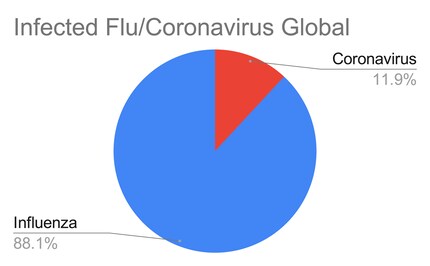
The number of deaths the flu has caused isn't known. But on December 2017, the WHO estimated 290,000 to 650,000 flu deaths per year. This corresponds to between 5,576 and 12,500 deaths per week or between 715 and 1,786 deaths per day. 31 days have passed since the coronavirus is being monitored and 132 corona deaths have been counted. That's 4.2, or 5, deaths per day.
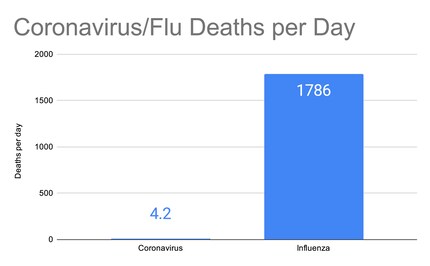
Despite these numbers, the flu is hardly mentioned anymore. 20 Minuten addressed the flu epidemic in Switzerland once on 15 January 2020 in an article titled «Flunami in Switzerland», which is based on a report by the Federal Office of Public Health, which reported 215 «flu-like illnesses» per 100,000 people in Switzerland. To put this into perspective: 11,081,000 people live in Wuhan. Of these, 5,997 people are infected with the coronavirus. This corresponds to an infection rate of 55 per 100,000 persons. Worldwide, the coronavirus has an infection rate of 0.08 per 100,000 people, based on a world population of 7.7 billion.
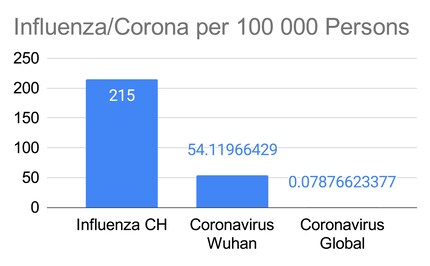
The hype about the coronavirus is – at least in Switzerland – not much more than an over-representation of the topic in the media. I used the free newspaper «20 Minuten» as an example, but this doesn't mean it's the only newspaper that's exploiting the topic to attract readers. The same thing is happening all over the place, resulting in the subject being exaggerated and misunderstood.
Should you still be careful? Yes, because it’s the flu season and the protective measures against 2019-nCoV will also help against the flu. The chances of you catching the coronavirus are small. The chances of you suffering serious consequences or even dying of it is minute. In Switzerland, that is. If you have the flu, stay home and get well. If you suffer from shortness of breath, better see a doctor sooner than later.
But there’s no need to expect an apocalypse.
Pictures of cities in this article are from Instagram User pandasquirrel. She took them in China on 28 January 2020.Journalist. Author. Hacker. A storyteller searching for boundaries, secrets and taboos – putting the world to paper. Not because I can but because I can’t not.
From the latest iPhone to the return of 80s fashion. The editorial team will help you make sense of it all.
Show all